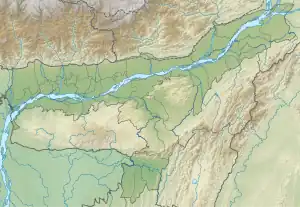
Daojali Hading is a neolithic site in Dima Hasao District of Assam, India on a low hillock about 1000 feet above sea level,[1] dated to about 2,700 years before present.[2] Excavated in 1961-63 by a team led by M C Goswami and T C Sharma,[3] it is the first stratified neolithic site discovered in Northeast India.[4] The excavation yielded typical shouldered celts and cord-marked pottery.[5] The cord-marked pottery is a unique characteristic that this site shares with Sarutaru and other Northeast Indian Neolithic sites[6] that is rare in the Indian Neolithic cultures—suggesting East and Southeast Asian cultural affinities, Hoabinhian in particular.[7][8]
Artifacts
The trial trench revealed that the site was single habitation—an unbroken two and a half feet deep cultural layer between an undisturbed brown earth and a layer of humus.[9] Pottery shreds and stone implements are scattered throughout the cultural layer. All ceramic materials are in fragments and cannot be utilized for reconstruction. They are of four types: cord-marked, incised, stamped, and plain fine red ware.[10] The plain fine red ware are made from well prepared fine clay on a turning device, whereas the other types are made from coarse and impure clay tempered with quartz and sandstone grits and beaten into shape with tools.[11] Situated near Brahmaputra valley close to routes leading into China and Myanmar. Extensive digging at the site has yielded polished stone tools, ceramics and kitchen items such as grinders, pestles and mortars. Jadeite stone was also found that must have been transported from China. A large number of pots have also been found. These findings suggest that the people there were growing and storing grains, and preparing food from it. According to historians, Neolithic phase here maybe as late as early Common Era centuries. Also common finds of tools made of fossil wood (ancient wood that has hardened into stone), and pottery.
Notes
- ↑ (Hazarika 2017:108)
- ↑ "Date obtained from Daojali Hading is 2.7 ± 0.3 ka (LD1728)" (Sharma & Singh 2017:492)
- ↑ "In 1961-3 the present writer had an opportunity to examine a stratified cultural deposit accidentally exposed on a hill-top in the north Cachar hills. The place, called Daojali Hading, is situated on a ridge of tertiary sandstone and shale which rises to a height of 1,500 feet."(Sharma 1967:126)
- ↑ (Sharma & Singh 2017:492)
- ↑ (Rao 1977:190)
- ↑ (Rao 1977:198)
- ↑ "The distribution of cord-marked pottery is well known. It occurs as a dominant ceramic ware in association with polished stone tools, including the shouldered axes, over a wide region of eastern Asia comprising China and the countries of southeast Asia (Cheng Te-k'un 1959: 80; Chang 1963: 129; Tweedie 1955; Peacock 1959: 149). The cord-marked pottery of Assam no doubt belongs to this eastern Asiatic neolithic traditions." (Sharma 1967:128)
- ↑ (Hazarika 2017:97)
- ↑ "A trial trench dug by us reveals that the cultural layer, which is superimposed upon an undisturbed layer of compact brown earth and sealed by a thin layer of humus, is about two and a half feet in thickness." (Sharma 1967:126)
- ↑ (Sharma 1967:127)
- ↑ (Sharma 1967:127)
References
- Hazarika, Manjil (2017). Prehistory and Archaeology of Northeast India. New Delhi: Oxford University Press. ISBN 978-0-19-947466-0.
- Rao, S N (1977). "Continuity and Survival of Neolithic Traditions in Northeastern India". Asian Perspectives. 20 (2): 191–205. JSTOR 42927958.
- Roy, Shankar Kumar (1977). A study of ceramics from neolithic to medieval period of Assam: an ethno-archaeological approach (PhD). Gauhati University. hdl:10603/69739.
- Sharma, Sukanya; Singh, Pankaj (2017). "Luminescence dating of Neolithic pottery in North East India" (PDF). Current Science. 113 (3): 492–496.
- Sharma, T C (1967). "A Note on the Neolithic Pottery of Assam". Man. 2 (1): 126–128. JSTOR 2798660.